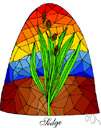sedge
(redirected from Sedges)Also found in: Thesaurus, Encyclopedia.
sedge
(sĕj)n.
Any of numerous grasslike plants of the family Cyperaceae, characteristically having solid three-sided stems, leaves arranged in three rows, and spikelets of inconspicuous flowers.
American Heritage® Dictionary of the English Language, Fifth Edition. Copyright © 2016 by Houghton Mifflin Harcourt Publishing Company. Published by Houghton Mifflin Harcourt Publishing Company. All rights reserved.
sedge
(sɛdʒ)n
1. (Plants) any grasslike cyperaceous plant of the genus Carex, typically growing on wet ground and having rhizomes, triangular stems, and minute flowers in spikelets
2. (Plants) any other plant of the family Cyperaceae
[Old English secg; related to Middle High German segge sedge, Old English sagu saw1]
ˈsedgy adj
Collins English Dictionary – Complete and Unabridged, 12th Edition 2014 © HarperCollins Publishers 1991, 1994, 1998, 2000, 2003, 2006, 2007, 2009, 2011, 2014
sedge
(sɛdʒ)n.
any rushlike or grasslike plant of the genus Carex, growing in wet places.
[before 900; Middle English segge, Old English secg, akin to saw1; presumably so named from its sawlike edges]
Random House Kernerman Webster's College Dictionary, © 2010 K Dictionaries Ltd. Copyright 2005, 1997, 1991 by Random House, Inc. All rights reserved.
Sedge, Sege
a collection of rush-like marsh plants, hence, a group of sea or marsh birds that use it as a nesting place. Also, siege.Examples: sedge of bitterns; of cranes; of herons—Bk. of St. Albans, 1486.
Dictionary of Collective Nouns and Group Terms. Copyright 2008 The Gale Group, Inc. All rights reserved.
ThesaurusAntonymsRelated WordsSynonymsLegend:
Switch to new thesaurus
| Noun | 1. |  sedge - grasslike or rushlike plant growing in wet places having solid stems, narrow grasslike leaves and spikelets of inconspicuous flowers sedge - grasslike or rushlike plant growing in wet places having solid stems, narrow grasslike leaves and spikelets of inconspicuous flowersCyperus alternifolius, umbrella sedge, umbrella plant - African sedge widely cultivated as an ornamental water plant for its terminal umbrellalike cluster of slender grasslike leaves chufa, Cyperus esculentus, earth almond, ground almond, rush nut, yellow nutgrass - European sedge having small edible nutlike tubers Cyperus longus, galingale, galangal - European sedge having rough-edged leaves and spikelets of reddish flowers and aromatic roots Cyperus papyrus, Egyptian paper reed, Egyptian paper rush, paper plant, paper rush, papyrus - tall sedge of the Nile valley yielding fiber that served many purposes in historic times Cyperus rotundus, nut grass, nut sedge, nutgrass, nutsedge - a widely distributed perennial sedge having small edible nutlike tubers Carex arenaria, sand reed, sand sedge - European maritime sedge naturalized along Atlantic coast of United States; rootstock has properties of sarsaparilla Carex pseudocyperus, cypress sedge - tufted sedge of temperate regions; nearly cosmopolitan cotton grass, cotton rush - any sedge of the genus Eriophorum; north temperate bog plants with tufted spikes hardstem bulrush, hardstemmed bulrush, Scirpus acutus - widely distributed North American sedge having rigid olive green stems Scirpus cyperinus, wool grass - sedge of eastern North America having numerous clustered woolly spikelets spike rush - a sedge of the genus Eleocharis bog plant, marsh plant, swamp plant - a semiaquatic plant that grows in soft wet land; most are monocots: sedge, sphagnum, grasses, cattails, etc; possibly heath |
Based on WordNet 3.0, Farlex clipart collection. © 2003-2012 Princeton University, Farlex Inc.
Translations
sara
sás
Collins Spanish Dictionary - Complete and Unabridged 8th Edition 2005 © William Collins Sons & Co. Ltd. 1971, 1988 © HarperCollins Publishers 1992, 1993, 1996, 1997, 2000, 2003, 2005
sedge
n → Riedgras nt, → Segge f
Collins German Dictionary – Complete and Unabridged 7th Edition 2005. © William Collins Sons & Co. Ltd. 1980 © HarperCollins Publishers 1991, 1997, 1999, 2004, 2005, 2007